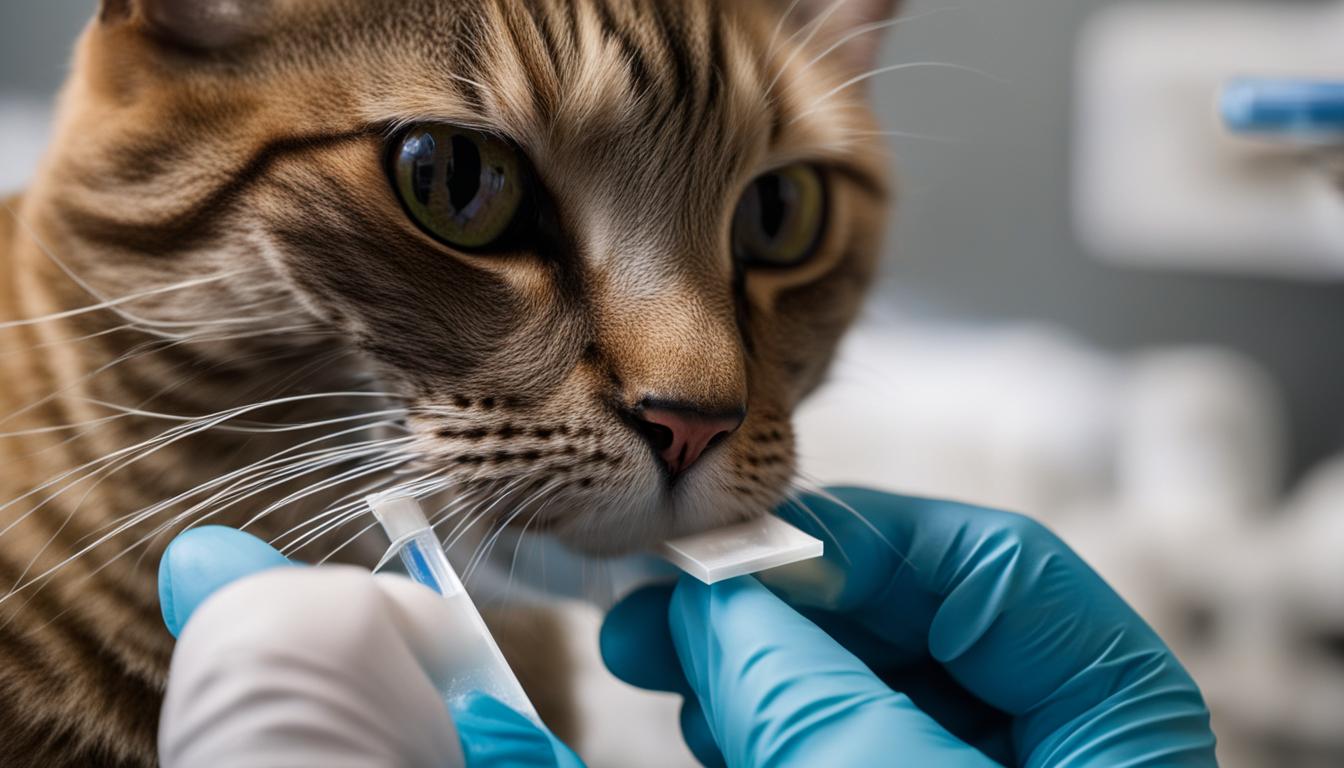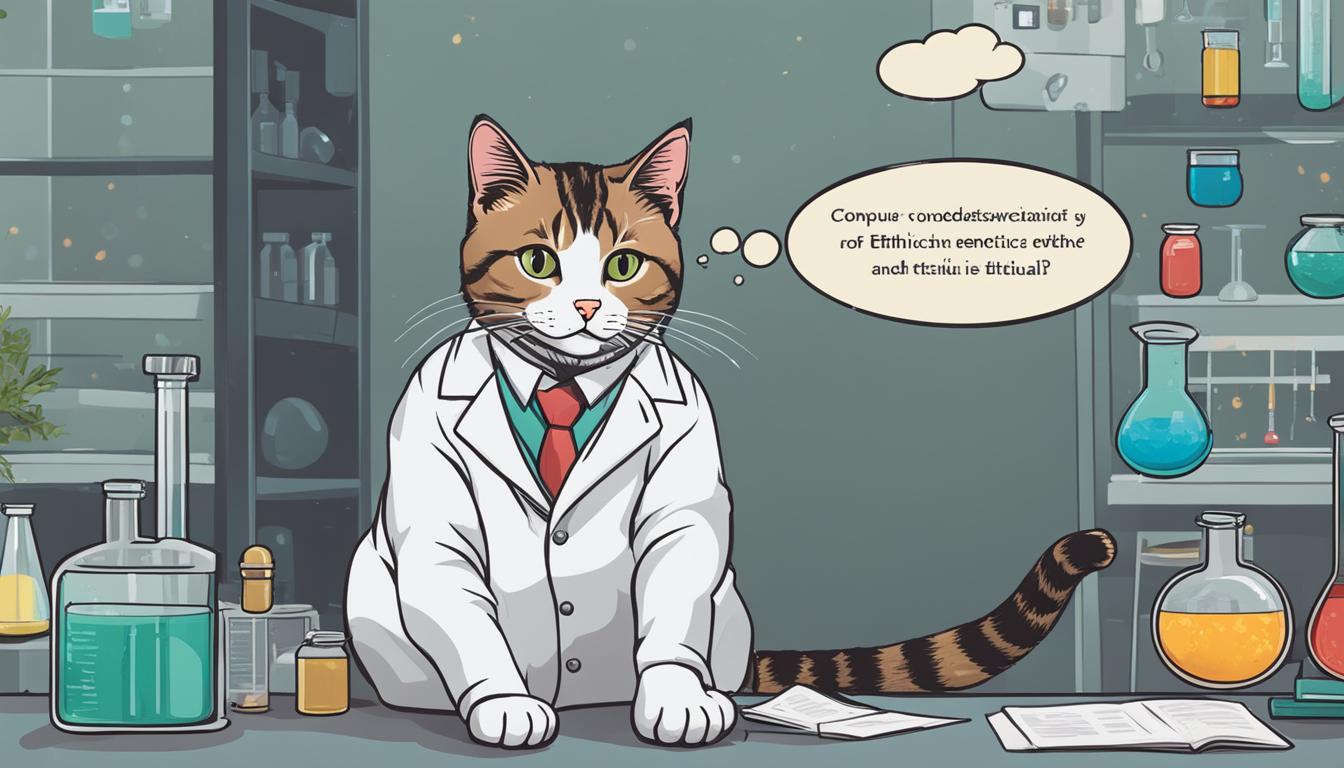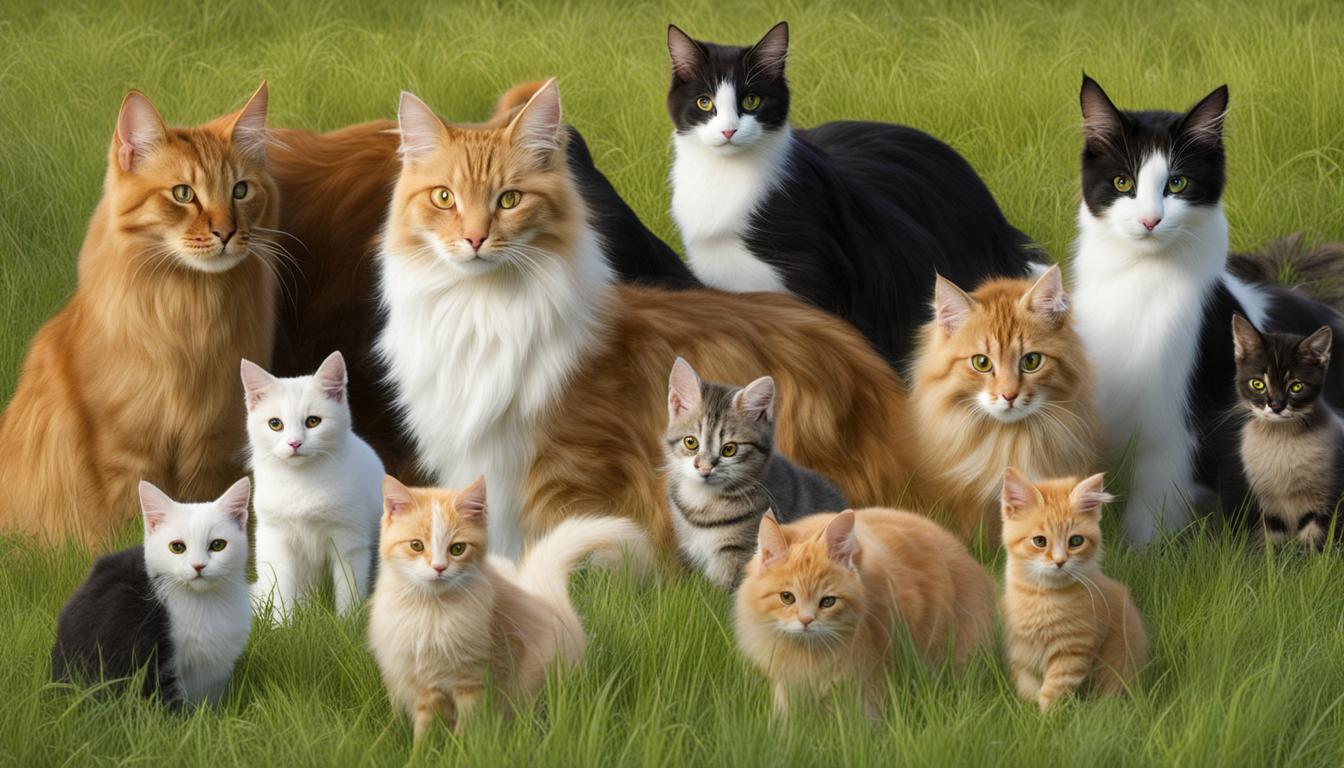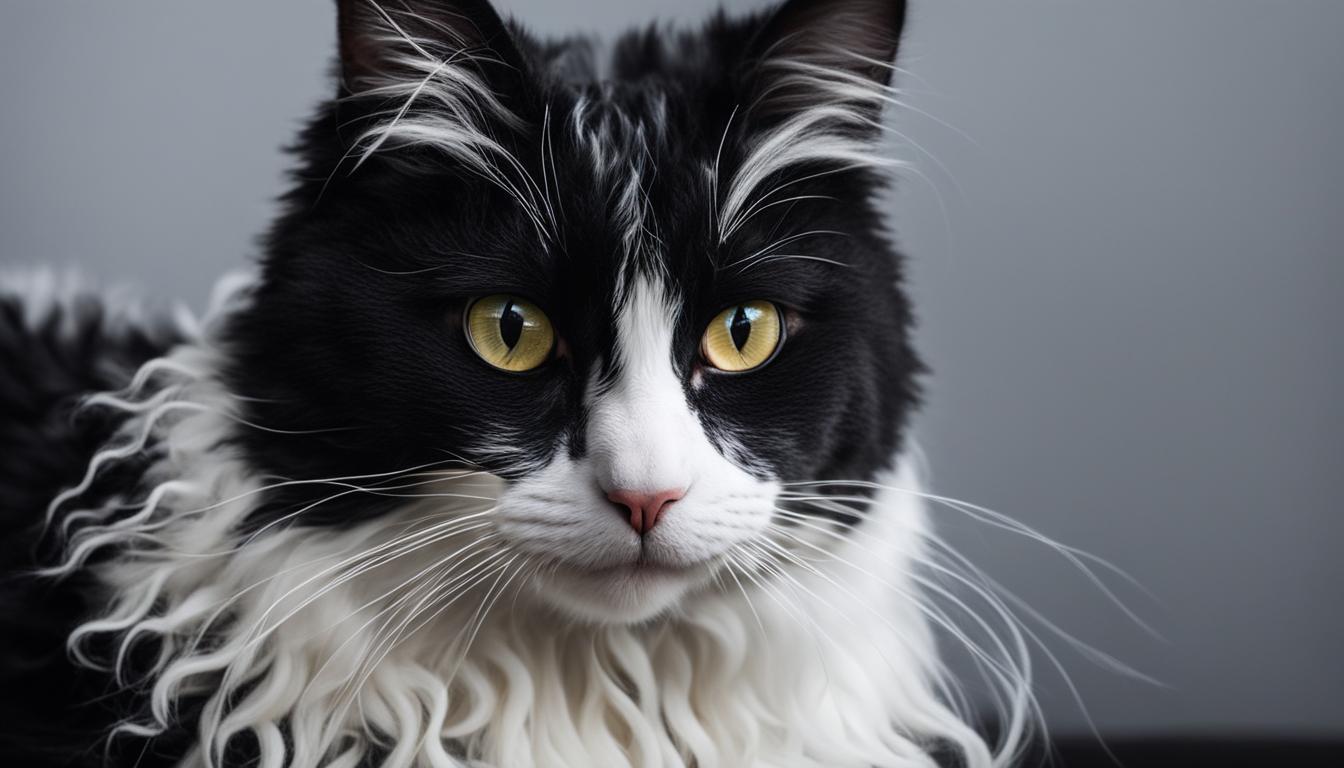Hey there, fellow feline enthusiasts! Today, I want to satisfy your curiosity by delving into the fascinating world of mixed-breed cats and their mysterious genetic lineage. Just like humans, cats have their own unique ancestry, and with the advent of DNA testing, we can now take a peek into their genetic past.
Have you ever wondered where your adorable mixed-breed kitty came from? Whether they have the soul of an ancient Egyptian or the spirit of a wild tiger? Well, you’re in for a treat! In this article, I’ll guide you through the world of genetic testing and help you uncover the secrets hidden within your furry friend’s DNA.
Key Takeaways:
- Genetic testing can provide valuable insights into the ancestry of mixed-breed cats.
- DNA testing is an effective way to determine the genetic background of your feline companion.
- Different regions of the world show distinct genetic clustering in mixed-breed cat populations.
- Pure breeding can lead to a loss of genetic diversity but doesn’t necessarily correlate with breed popularity or age.
- Uncover the hidden secrets of your mixed-breed cat’s genetic heritage and embark on a fascinating journey through their ancestral lineage.
The History of Domestic Cats
The domestication of cats is a fascinating tale that dates back thousands of years. It is believed that cats were first domesticated in the Near East around 9,000-10,000 years ago. This process coincided with the rise of agriculture in the Fertile Crescent, where humans began cultivating crops and storing surplus grains. As humans settled into agricultural lifestyles, cats were drawn to the abundance of rodents attracted to the stored food.
Throughout history, cats spread to different parts of the world through trade routes between ancient civilizations. Their presence was valued not only for their ability to control crop-destroying rodents but also for their companionship. Cats became an integral part of human societies and were even revered in some cultures. Ancient Egyptians, for example, worshiped cats and believed they possessed protective qualities.
“The domestication of cats began when humans transitioned to agricultural lifestyles, and cats spread to different parts of the world through trade routes between ancient civilizations.”
The history of domestic cats is a testament to the symbiotic relationship between humans and animals. Cats provided a valuable service by controlling pests, while humans offered protection and a source of food. Today, cats continue to be cherished pets, bringing joy and companionship to millions of households worldwide.
Cat Breeds and Genetic Diversity
Cat breeds have become increasingly popular in recent years, with many people drawn to the unique characteristics and traits associated with specific breeds. However, the development of these breeds has raised concerns about genetic diversity and the potential negative effects of inbreeding.
Inbreeding, which involves mating closely related individuals, can lead to a loss of genetic diversity within a breed. This loss of diversity can increase the risk of inherited diseases and health issues among purebred cats. It also limits the ability of breeders to introduce new genetic variations and traits.
A study conducted on the genetic diversity of different cat breeds found that pure breeding has indeed resulted in decreased genetic diversity for certain breeds. However, the study also revealed that this loss of diversity does not necessarily correlate with a breed’s popularity or age. Some older and less popular breeds showed higher levels of genetic diversity compared to newer and more popular breeds.
| Breed | Genetic Diversity |
|---|---|
| Persian | Low |
| Munchkin | Medium |
| Maine Coon | High |
| Bengal | Low |
This variability in genetic diversity among cat breeds suggests that breed popularity and age may not be the sole determining factors in the loss of genetic diversity. Other factors, such as breeding practices and the specific genetic makeup of individual breeds, also play a role.
It is important for breeders and cat owners to be aware of the potential genetic health issues associated with certain cat breeds and to work towards maintaining and improving genetic diversity. Responsible breeding practices, including outcrossing with unrelated breeds and regular genetic testing, can help mitigate the negative effects of inbreeding and preserve the overall health and well-being of cat breeds.
Characteristics that Hint at a Cat’s Breed
When it comes to determining the breed of a mixed-breed cat, it can be challenging to rely solely on physical characteristics. However, certain traits can provide clues about a cat’s potential breed ancestry. These traits encompass both physical and behavioral aspects that are commonly associated with specific cat breeds.
Physical traits are often the first indicators of a cat’s potential breed ancestry. Size is one such characteristic that can give insights into a cat’s lineage. For example, Maine Coons are known for their large size, with males weighing up to 18 pounds or more. On the other hand, Siamese cats have distinctive facial features, including their signature blue almond-shaped eyes.
Behavioral traits can also offer clues about a cat’s breed background. For instance, the Siamese breed is known for its vocal nature and tendency to communicate through meows. Ragdolls, on the other hand, are known for their docile and relaxed temperament, making them excellent companions for families.
Physical traits that can indicate a cat’s breed:
- Fur length and texture
- Coloration and pattern
- Eye color and shape
- Ear shape and size
- Body structure and size
Behavioral traits that can indicate a cat’s breed:
- Vocalization patterns
- Energy levels and activity preferences
- Temperament and sociability
- Playfulness and curiosity
- Intelligence and trainability
“The physical and behavioral traits of cat breeds are fascinating clues that can help unravel the mystery of a mixed-breed cat’s ancestry. While genetics play a significant role, observing these characteristics can provide valuable insights into their potential breed background.” – Feline Genetics Expert
It’s important to note that while these characteristics can hint at a cat’s potential breed ancestry, they are not definitive proof of their lineage. Genetic testing is the most accurate method for determining a cat’s breed composition. However, it’s important to remember that mixed-breed cats are unique individuals, and their diverse backgrounds make them special in their own right.
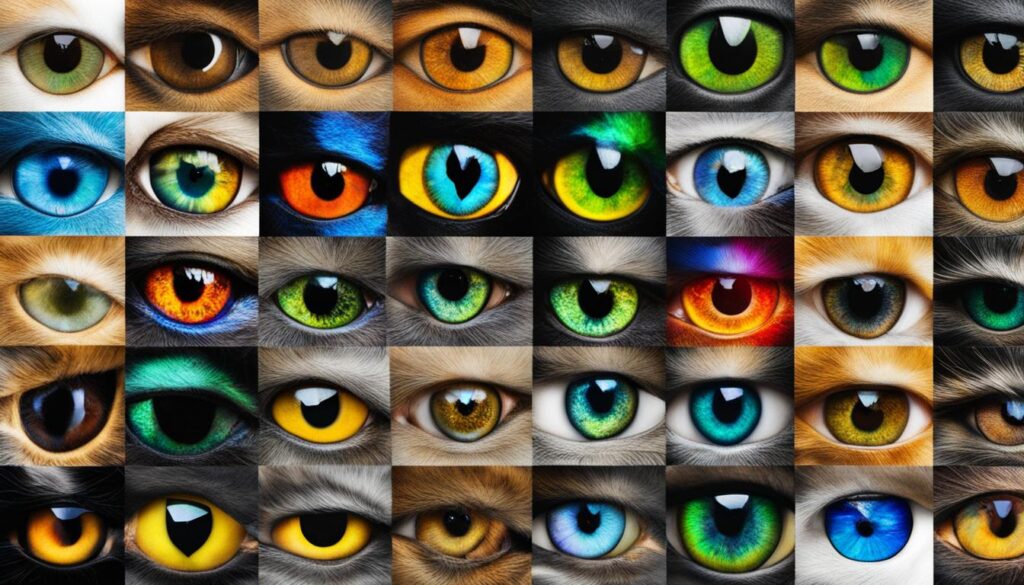
Health Considerations for Mixed-Breed Cats
When it comes to health, mixed-breed cats have a few advantages over their purebred counterparts. While all cats are susceptible to common diseases, such as cancer, diabetes, feline immunodeficiency virus (FIV), and feline leukemia (FeLV), mixed-breed cats are generally less prone to breed-specific health issues. This is because their genetic diversity helps protect them from inheriting genetic disorders that are more prevalent in certain breeds.
Regular veterinary care is essential for ensuring the well-being of mixed-breed cats. Routine check-ups, vaccinations, and preventive treatments can help detect and manage any potential health problems early on. Additionally, maintaining a healthy weight through a balanced diet and regular exercise can contribute to their overall health and longevity.
While mixed-breed cats may have a lower risk of breed-specific health issues, it’s important to remember that every cat is unique, and health concerns can still arise. Being attentive to any changes in your cat’s behavior, appetite, or physical appearance is crucial for early detection and appropriate intervention. By providing them with a safe and loving environment, along with routine veterinary care, you can ensure that your mixed-breed cat leads a happy and healthy life.
Common Diseases in Cats
Common diseases in cats can affect both purebred and mixed-breed cats alike. Here are some of the most prevalent health issues that you should be aware of:
- Cancer: Cats can develop various types of cancer, including lymphoma, mammary tumors, and squamous cell carcinoma.
- Diabetes: This metabolic disorder occurs when cats are unable to regulate their blood sugar levels properly.
- Feline Immunodeficiency Virus (FIV): FIV is a retrovirus that weakens a cat’s immune system, making them more susceptible to infections and diseases.
- Feline Leukemia (FeLV): FeLV is another retrovirus that can lead to severe immunodeficiency and increase the risk of developing various health issues.
Remember, regular veterinary care, a balanced diet, and a safe environment are key to maintaining your cat’s health and well-being. By being proactive in monitoring your mixed-breed cat’s health and providing appropriate care, you can help them live a long and happy life.
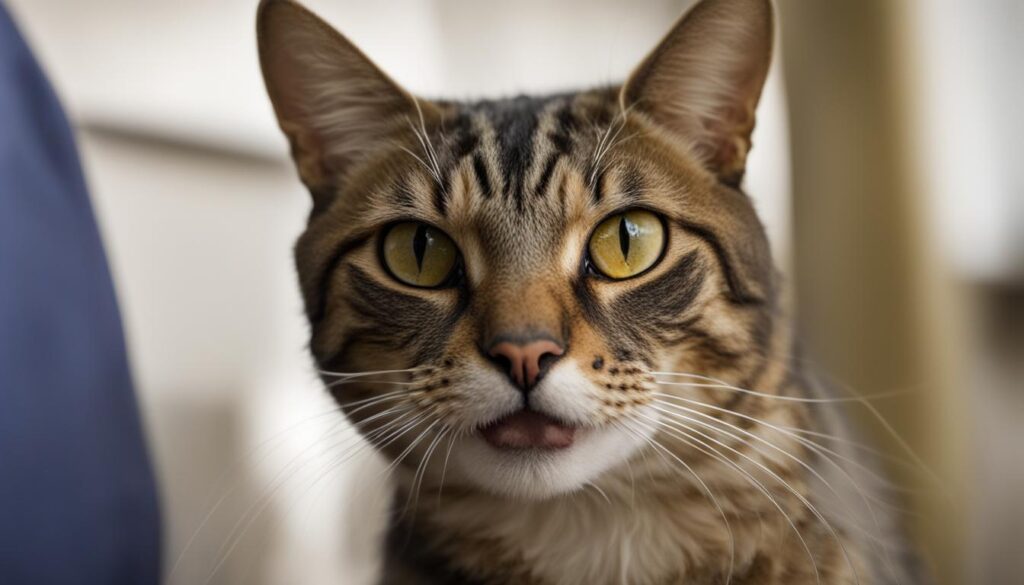
Cat Care Tips for Mixed-Breed Cats
When it comes to caring for your mixed-breed cat, there are a few important factors to consider. Grooming plays a vital role in maintaining your cat’s overall health and appearance. Regular brushing helps to remove loose hair, reduce the risk of hairballs, and keep your cat’s coat looking sleek and shiny. Additionally, trimming your cat’s nails on a regular basis will help prevent them from becoming too long or sharp.
Giving your mixed-breed cat a safe and comfortable environment is also crucial. While some cats enjoy the great outdoors, it’s generally recommended to keep your cat indoors. Indoor cats have a lower risk of encountering dangers such as traffic, predators, and communicable diseases. Providing your cat with plenty of toys, scratching posts, and climbing structures will help keep them entertained and mentally stimulated.
Proper nutrition is essential for the well-being of your mixed-breed cat. Choose a high-quality cat food that meets their specific nutritional needs. It’s important to feed your cat the appropriate amount of food for their age, size, and activity level. Always make sure fresh water is available for your cat to stay hydrated. If you have any concerns about your cat’s diet or nutrition, consult with your veterinarian for guidance.
Grooming Tips for Mixed-Breed Cats
Here are some grooming tips specifically tailored for mixed-breed cats:
- Brush your cat’s fur at least once a week to prevent matting and remove loose hair.
- Use a brush or comb that is suitable for your cat’s coat length and texture.
- Pay extra attention to areas like the belly, armpits, and behind the ears, as these can be prone to matting.
- If your cat has long hair, consider regular trimming or professional grooming to prevent excessive hair accumulation and discomfort.
Indoor Cat Care Tips
Here are some tips to ensure the well-being of your indoor mixed-breed cat:
- Create a safe and stimulating environment by providing scratching posts, climbing trees, and interactive toys.
- Establish a regular playtime routine to keep your cat physically active and mentally engaged.
- Monitor your cat’s weight to prevent obesity, which can lead to health issues.
- Keep your cat’s litter box clean and easily accessible.
- Provide hiding spots and comfortable resting areas for your cat to relax.
Overall, by following these cat care tips, you can ensure that your mixed-breed cat stays healthy, happy, and well-groomed. Remember, each cat is unique, and it’s important to understand their individual needs and preferences. Taking good care of your mixed-breed cat will strengthen the bond between you and provide them with a fulfilling and enriched life.
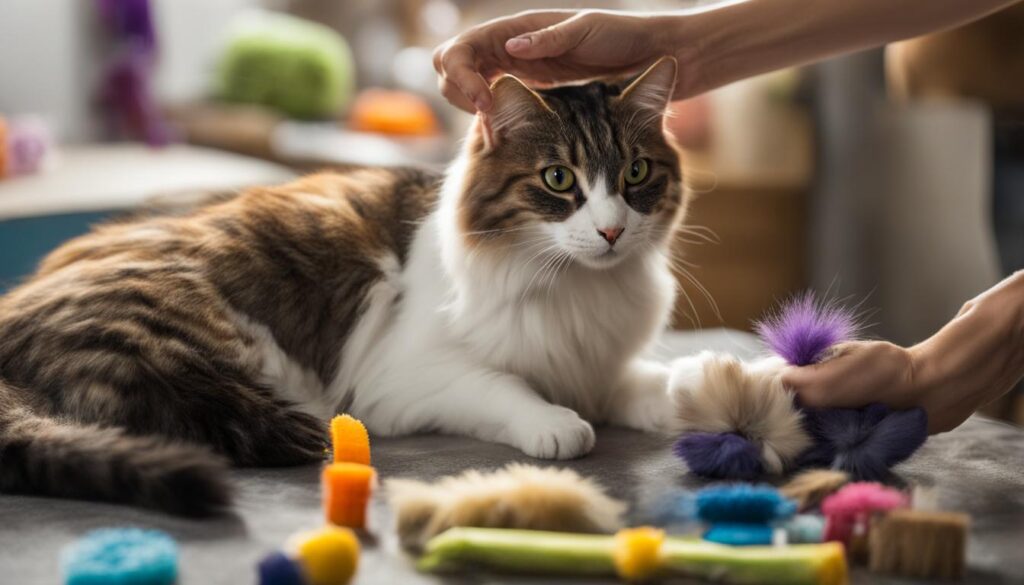
Finding Mixed-Breed Cats for Adoption
Adopting a mixed-breed cat can be a wonderful way to give a deserving feline a loving home. One of the best places to find these cats is at adoption shelters. These shelters are home to countless shelter cats, including a wide variety of mixed-breed cats with unique colors, patterns, and personalities. By adopting from a shelter, you not only provide a loving home for a cat in need but also support the important work that shelters do in rescuing and caring for homeless cats.
When you visit an adoption shelter, you will have the opportunity to interact with the cats and get to know their personalities. Shelter staff can provide valuable information about each cat’s background and behaviors, helping you make an informed decision about which cat is the best fit for your home and lifestyle. Whether you’re looking for a playful companion or a laid-back cuddler, you’re likely to find a mixed-breed cat that matches your preferences at a shelter.
Adopting a shelter cat is a rewarding experience that comes with numerous benefits. Mixed-breed cats tend to be healthy and resilient, as they have a diverse genetic background that can help protect them from breed-specific health issues. Additionally, when you adopt a mixed-breed cat, you are giving them a second chance at a happy life, providing them with love, care, and a forever home.
| Advantages of Adopting Mixed-Breed Cats | Why Adoption Shelters are the Best Option |
|---|---|
| 1. Diverse genetic background reduces the risk of breed-specific health issues. | 1. Home to countless mixed-breed cats with unique colors, patterns, and personalities. |
| 2. Resilient and adaptable, making them well-suited to a variety of living situations. | 2. Shelter staff can provide valuable information about each cat’s background and behaviors. |
| 3. Every adoption supports the important work of shelter organizations. | 3. Interacting with the cats helps you make an informed decision about the best fit for your home and lifestyle. |
By considering the option of adopting a mixed-breed cat from a shelter, you not only gain a loving and loyal companion but also contribute to the well-being of homeless cats and the efforts of animal shelters. So, why not open your heart and home to a mixed-breed cat in need? Their gratitude and love will be the greatest reward.
Additional Tips for Adopting a Mixed-Breed Cat
- Take your time when visiting the adoption shelter to interact with different cats and find the one that best matches your personality and lifestyle.
- Ask the shelter staff about each cat’s medical history, vaccinations, and any specific care requirements they may have.
- Consider adopting an adult or senior mixed-breed cat, as they often have more predictable temperaments and may be house-trained.
- Prepare your home for the arrival of your new cat by providing necessary supplies like litter boxes, scratching posts, and cozy beds.
- Once you bring your mixed-breed cat home, give them time to adjust to their new environment and establish trust with you.
“Adopting a mixed-breed cat is not only a kind and compassionate choice, but it’s also a decision that brings endless joy and love into your life.”
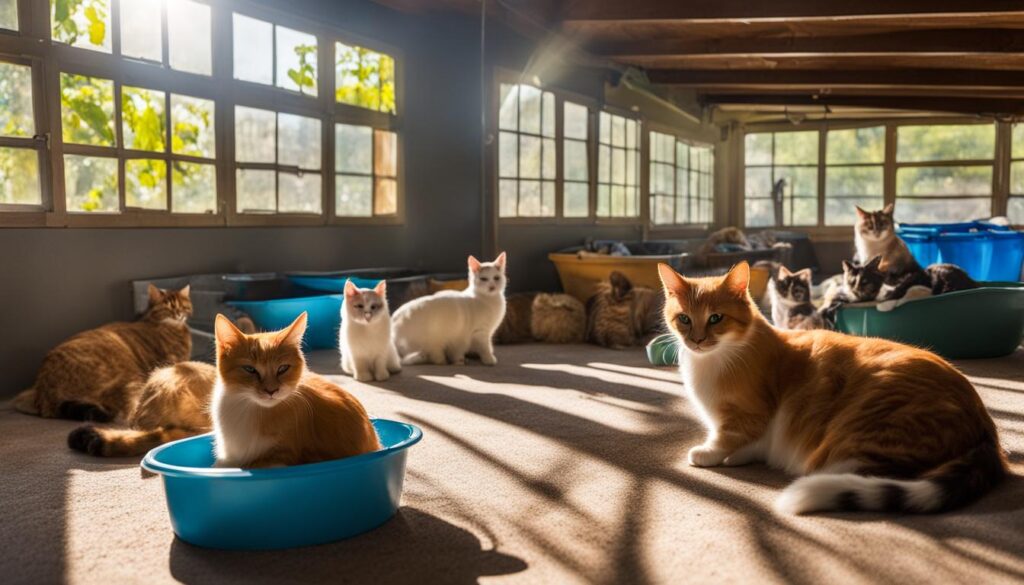
Conclusion
Tracing the genetic lineage of mixed-breed cats is like embarking on a feline adventure, full of intrigue and curiosity. These enigmatic creatures with their diverse backgrounds pose an exciting challenge when it comes to uncovering their ancestry. While genetics may play a role in determining a cat’s breed, it’s fascinating to observe the physical and behavioral traits that can provide us with clues.
But let’s not forget that mixed-breed cats offer more than just a genetic puzzle to solve. They bring with them a unique blend of personalities, quirks, and charms that make them truly special companions. Adopting a mixed-breed cat from a shelter not only gives a deserving cat a loving home but also allows you to experience the joy of having a one-of-a-kind feline friend.
When it comes to mixed-breed cat adoption, it’s not just about bringing home a pet; it’s about opening your heart to a new chapter of love and companionship. These precious feline souls may have complex genetic lineages, but they have so much love to give. So, if you’re ready to embark on a journey of discovering a cat’s ancestry while making a difference in their lives, consider adopting a mixed-breed cat and let the adventure begin!
FAQ
Can DNA testing determine the genetic lineage of mixed-breed cats?
Yes, DNA testing can provide insights into the genetic lineage of mixed-breed cats by analyzing microsatellite markers.
When and where were cats domesticated?
Cats were domesticated approximately 9,000-10,000 years ago in the Near East, specifically in the Fertile Crescent where humans transitioned to agricultural lifestyles.
Does pure breeding lead to a loss of genetic diversity in cats?
Yes, pure breeding can result in a loss of genetic diversity in cats, but this does not necessarily correlate with breed popularity or age.
What are some characteristics that can hint at a cat’s breed?
Size, hair length, face shape, and temperament are some traits that can provide clues about a cat’s potential breed ancestry.
Are mixed-breed cats healthier than purebred cats?
Generally, mixed-breed cats tend to be healthier than purebred cats as they are not prone to breed-specific diseases. However, they are still susceptible to common cat diseases such as cancer, diabetes, feline immunodeficiency virus, and feline leukemia.
How should mixed-breed cats be cared for?
Mixed-breed cats require regular grooming, including brushing and nail trimming. It is also important to provide them with a balanced diet, fresh water, and ample opportunities for play and exercise. Keeping them indoors-only can help protect them from outdoor risks and prolong their lifespan.
Where can I find mixed-breed cats for adoption?
Adoption shelters are the best places to find mixed-breed cats. These shelters house numerous homeless cats of different colors, patterns, and personalities waiting for loving families.

